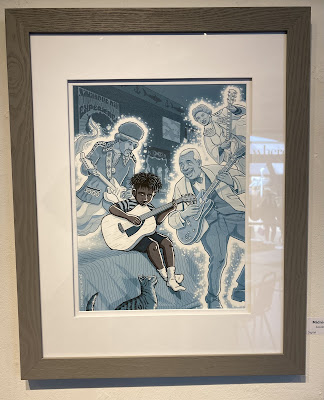March is Women’s History Month. It is also Music in Our Schools Month. Not to overlook women (and I hardly could be accused of that) but it is music that’s on my mind this morning.
One of the pieces in the Beyond the Blues art exhibit at the Columbia Art Center that stayed with me was this one. It’s entitled “Midnight Lesson” and it’s a digital entry by artist Jacob Thompson.
At first glance the picture tells a story of a young Black boy (playing a rather outsized guitar) who is surrounded and inspired by the spiritual presence of three great Black musicians: Jimi Hendrix, BB King and Sister Rosetta Tharpe. It feels like a visitation from the ancestors.
In music there is always much to be learned by those who came before us. That’s true whether we are studying 18th century Common Practice Harmony or the Blues.
The reason I’m sharing the picture with you today is because music education on the whole has leaned far too heavily on reverence for the white forbears whose work is rooted in 18th Century Common Practice Harmony. This has meant a general exclusion of other forms of music created and sustained by other kinds of people. If you reviewed every concert program and every festival and assessment program in Howard County this year you would find the music to be primarily written by white male composers, many of them dead.
In American music education as a whole there has been far too much emphasis on teaching white music and standard notation as “real music”. Musical forms which are passed along in the oral tradition and/or value improvisation are kept on the other side of a gate. Awards for musical excellence go to those who conform to the study of “real music.”
With that in mind I look at the image created by Jacob Thompson and feel a bit sad. I think of all the kids who want to make music whose only experience with the music of Hendrix, King, and Tharpe is likely to come in a midnight lesson. There’s no room for it in school, unless it is in a “special” lesson in a “special” month that ticks the boxes for diversity and inclusion. Until next year.
Learning about music beyond the white, Common Practice Harmony boundaries of standard notation is good for everyone, not just small Black children (with rather large guitars.) It should not be a lonely pursuit. It should be inclusive, honored, joyful.
Music teachers perpetuate what they themselves were taught in college training programs. Their students grow up to do the same, in many cases. Their earnest desire is for musical excellence. Yet the result can be narrow and exclusionary. It can produce programs that take pride in how many people they can winnow out rather than all the students they can engage and inspire.
Howard County has excellent music programs and dedicated, gifted teachers. Our curriculum has grown over the years to encompass World Drumming, Guitar, and Music Technology. Some of the best things that are happening at school happen in music rooms: not just musically and academically, but also creatively, and in ways that support executive functioning, teamwork, student self-esteem and a host of soft skills that prepare students for a happy and successful life.
The better we get at fostering diverse and inclusive musical environments, the more that can happen.
One last thing: today’s piece is not meant to imbue the image by Jacob Thompson with sadness or disappointment. It shows us a holy moment. But perhaps it asks us, “What do you mean, ‘Beyond the Blues’? Some days the Blues are all that you need.”
About Jacob Thompson:
Jacob Thompson is a Maryland based illustrator focusing on middle grade and picture book illustration. He is currently available for freelance.
You can see more of Thompson’s work on his Facebook page: Jacob Thompson Illustration.


Comments
Post a Comment